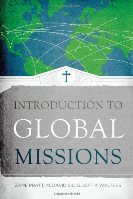Reviewed by Anthony Casey
Introduction to Global Missions is written by a trio of seasoned missions professors and practitioners and serves as a general introduction to the theology and practice of missions in a rapidly changing 21st century world. The book is primarily intended for use as a textbook in Bible colleges and seminaries, but serves equally well in the hands of pastors, lay leaders, and even missionaries themselves who are looking for a good orientation to all that is missions.
Overview
The authors structure the book via four sections, following the missiological helix commonly used to frame missions – biblical and theological foundations, historical foundations, the importance of understanding culture and world religions, and then concludes with a section covering practice and strategy. The book helpfully begins with an orientation to the missionary call in general, which originates with God initiating mission through His plans and purposes to redeem a fallen world, and extends to churches and individuals who respond to the special call to take to the gospel across cultural and linguistic lines to the lost world. The book concludes by bringing the reader up to date on current issues in missions such as the role of short-term missions, globalization, urbanization, technological advance, and the changing nature of access to countries as they close to overt missionary presence.
Contributions
Introduction to Global Missions makes two unique contributions to the study of missions. First, the authors present a comprehensive theological foundation for missions that understands there is a missiological basis for the Bible itself, rather than merely present a “biblical” basis for missions that proof-texts Scripture for support. God is a missionary God. His plan to redeem the nations was in place even before He created the world and its peoples. The Bible presents a key storyline that follows the contours of Creation, Fall, Redemption, and Fulfillment. Throughout Scripture, God is establishing His kingdom and uses human agents to carry out the task. Missions did not begin with the Great Commission in Matthew 28. Rather, missions flows out of the very essence of God and is seen throughout the Bible. This distinction is great and one that is needed as money and resources seem to be drying up here in the United States and mission agencies are drawing down their field personnel and restricting where they send people. Missions is not a side task for the church when it has time and resources. Introduction to Global Missions brings the church back to where it should be – a gathering of believers that exists to operate in accordance with the will of God, and a will that is decidedly and unavoidably missionary!
Second, the book provides insight into how the local church can take back the sending and support of missionaries. In recent decades, “missions” has been farmed out to agencies that are becoming increasingly disconnected from the local church. The authors here reorient the process and bring it back into the local church and provide guidelines for working with denominations and mission agencies. In this regard, the book is helpful for pastors who may have never thought of themselves as missionaries. All pastors should be equipped to help shepherd their flock toward global missions and facilitate those in their congregations God is calling into missions. This book is one great step toward that necessary equipping.
Assessment
Introduction to Global Missions succeeds in its attempt to provide a solidly biblical and theologically grounded approach to missions. The four field approach of theology, history, culture, and strategy provides as comprehensive an introductory treatment of missions as one could expect in a textbook of reasonable length. As noted above, the strengths of the book include the chapters on the biblical and theological basis for missions and a renewed emphasis on the role of the local church in sending and supporting missionaries.
The authors shed light into key issues such as the exclusivity of the gospel, how Christians should understand and engage world religions, the impact of culture on the missionary task, and present a challenge for a robust pattern of discipleship with new believers on the field as new churches are started. The authors’ field experience shines through as they discuss issues not always apparent for missionaries such as leaving the home culture, transitioning to the field, learning new languages, and adjusting to new cultures. These difficult issues are treated realistically, and the authors provide insight and encouragement from their own experience.
One area that would be welcomed is a more thorough treatment of spiritual warfare in missions. The demonic is mentioned some in the sections on animism and world religions, but there is little mention of how missionaries should respond to popular teachings found on the field purporting strategies for engaging territorial spirits, prayer evangelism, exorcisms, and so on.
Overall, the book is well-rounded and balanced and I recommend Introduction to Global Missions as a general textbook for a course on missions. Professors can be confident the authors know what they are writing about and the book is borne from years of experience. Additionally, all sections of the book are well grounded in Scripture – especially refreshing in the chapters on culture and strategy. Furthermore, the book is well suited to pastors, lay leaders, and anyone considering a call to missions. The book is very readable, accessible, and insightful and truly does introduce the realities of global missions in the 21st century.
Anthony Casey, PhD, lives in SE Asia and teaches courses in anthropology and urban missions.
